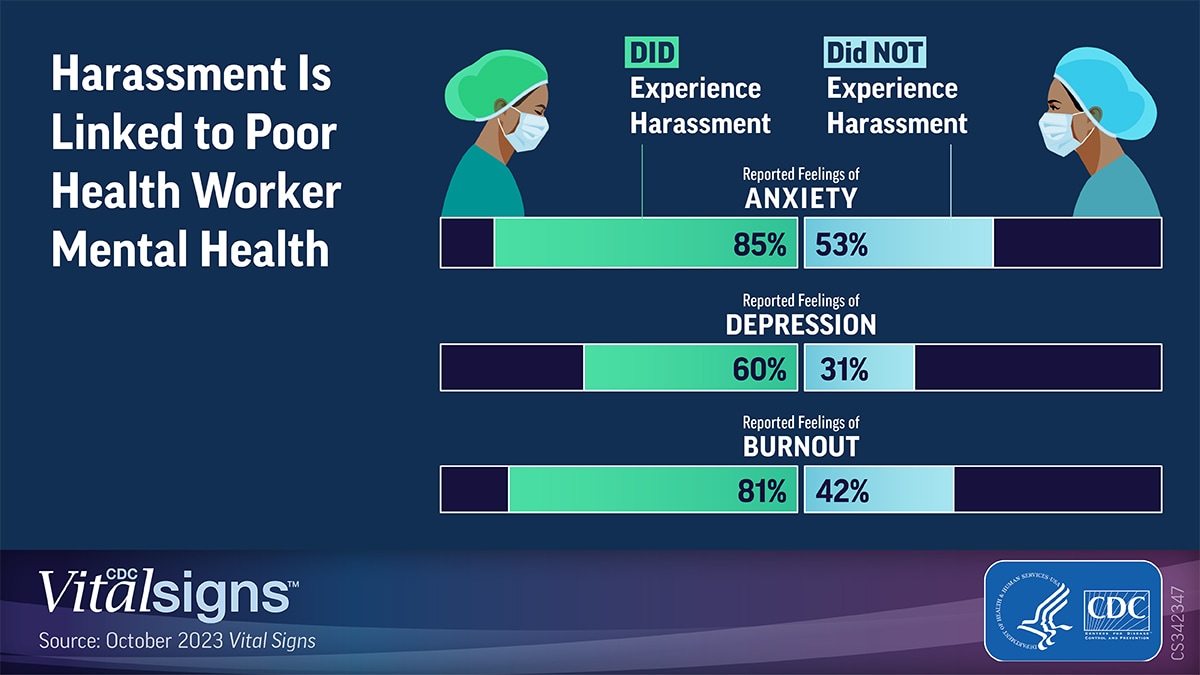Health Workers Report Harassment, Symptoms of Poor Mental Health, and Difficult Working Conditions
More than double the number of health workers reported harassment at work in 2022 than in 2018. This may include threats, bullying, verbal abuse, or other actions from patients and coworkers that create a hostile work environment. This finding has important implications for health worker mental health, according to a new CDC Vital Signs report.
Health worker burnout was at crisis levels prior to the COVID-19 pandemic. The new Vital Signs issue reports that the pandemic presented unique challenges that may have further impaired health worker mental health and increased health workers’ intent to leave their jobs.
- This report is the first to describe and compare self-reported well-being and working conditions for health workers, other essential workers, and all other workers before the pandemic (2018) and after the start of the pandemic (2022). It shows that health workers have continued to face a mental health crisis. From 2018 to 2022, U.S. health workers experienced greater declines on a range of mental health outcomes than other workers.
- Positive working conditions were found to be associated with reduced feelings of anxiety, depression, and burnout. These conditions may include the ability to participate in decision-making, trust in management, supervisor assistance, enough time to complete work, support for productivity, and lack of harassment.
“We depend on our nation’s health workers and they must be supported. Employers can act now by modifying working conditions associated with burnout and poor mental health outcomes in health settings. And, CDC’s National Institute for Occupational Safety and Health (NIOSH) will be launching a national campaign—the Impact Wellbeing campaign—to provide health employers with resources to improve worker mental health,” said CDC Chief Medical Officer Debra Houry, M.D., M.P.H.
These data further support the imperative given in the U.S. Surgeon General’s 2022 report, Addressing Health Worker Burnout, which emphasized the need for action to create a system where health workers can thrive.
“CDC’s efforts to address health worker mental health come at the right time, as we see how health workers have self-reported a unique increase in poor mental health, especially after a global pandemic,” said L. Casey Chosewood, M.D., M.P.H., director of the National Institute for Occupational Safety and Health’s Office for Total Worker Health®. “In this study, we saw that when working conditions are positive, and where health workers are supported and have the potential to thrive, poor mental health outcomes were less likely. Employers can make a critical difference here by taking preventive actions and improving difficult working conditions that are linked with anxiety, depression, and burnout.”
A Call to Action:
- To promote worker well-being, employers can modify working conditions and change aspects of the organizational structure that are associated with poor mental health. This study suggests such changes could include allowing health workers to participate in decision-making, building trust in management, providing supervisor assistance and enough time to complete work, and preventing and paying attention to harassment reports.
- Employers can learn more about health workers and mental health through NIOSH’s Health Worker Mental Health Initiative, and about mental health in general. Visit the NIOSH Total Worker Health® Program and the Healthy Work Design and Well-Being Program to learn more about how work conditions and work design impact worker well-being.
- Supervisors and workers can discuss ways to improve working conditions. For both supervisors and employees, NIOSH has training and resources for health workers on stress, fatigue, burnout, substance use, and suicide.
- The general public can support health workers by expressing appreciation for their essential work and treating them with understanding and respect.
If you or someone you know needs support now, call or text 988 or chat 988lifeline.org. 988 connects you with a trained crisis counselor who can help.
If you or someone you know needs assistance (in English or Spanish) with mental health concerns and/or substance use disorders, prevention, and recovery, please contact SAMHSA’s National Helpline at 1-800-662-HELP (4357) or visit https://www.samhsa.gov/find-help.
For more information about this report, go to www.cdc.gov/vitalsigns.

